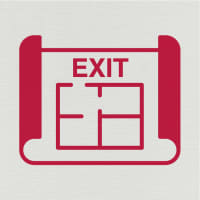Childproofing & Fire Safety for New Parents
With a new baby at home, you could probably use a little help with shoring up your fire safety for your new family. And as babies become toddlers, childproofing your home becomes important, too.
Fire Safety Tips for Babies
|
|
|
Just like that practice plan you had for getting to the hospital when the time came, make a new fire escape plan for your new family to increase your chances of getting out safely. | Designate one person to get infants and small children out safely. Have a backup plan for young children just in case the primary person is overcome by smoke. | Remember to keep space heaters at least three feet away from anything that can burn, and always closely supervise children and pets when a heater is turned on. Make sure you turn heaters off when you leave the room. |
|
| |
Don’t hold a baby while carrying anything hot or when cooking on the stove. | If using gasoline-powered devices, store gasoline in a locked location where children cannot access it. Keep only small quantities in an approved container that has child safety features. | |

Carbon Monoxide (CO) Prevention
CO poisoning can happen much, much quicker with little ones, so proper operation and placement of CO alarms is vital.
- Install at least one battery-powered CO alarm or AC-powered unit with battery backup on each level of your home and near sleeping areas.
- Replace CO alarms every five to seven years to benefit from the latest technology upgrades.
- Digital CO alarms like Kidde’s C3010D (see below) are perfect because you can see exactly how much CO is being detected. 70 PPM would be an unsafe level for an adult, for instance. But just 30 PPM can be dangerous for a young child.
Smoke + Carbon Monoxide Alarm with smart features
Mobile alerts are sent to your phone when smoke or CO is detected, even when you aren’t at home. Ideal for providing new parents with peace of mind when they’re ready to leave the little ones with a sitter.

Childproofing as They Get Older**
- Children playing with fire cause hundreds of deaths and injuries each year. Preschoolers and kindergartners are most likely to start these fires, typically by playing with matches and lighters.
- Children experience fire interest. They may ask questions such as “how hot is fire?” or show an interest through playing with fire trucks or cooking on a play stove. This is healthy, and an opportunity to begin education.
- Many fires happen when young children are left alone and have access to matches and lighters. Parents must have clear rules and consequences about fire misuse.
- Store matches and lighters out of children’s reach and sight, up high, preferably in a locked cabinet or container.

- Teach children to tell a grown-up if they see matches or lighters. Children need to understand that fire is difficult to control, it is fast and can hurt as soon as it touches you.
- Never assign a young child any tasks that involve the use of a lighter or matches (lighting candles, bringing a lighter to an adult to light a cigarette or the fireplace, etc.)
- Use only lighters designed with child-resistant features. But remember, child-resistant does not mean child-proof.
- If you suspect your child is intentionally setting fires or unusually fascinated with fire, get help. Your local fire department, school, or community counseling agency can put you in touch with trained experts who know how to teach children about fire in an appropriate way.
**Much of the information is provided by the NFPA (National Fire Protection Association). Pay them a visit to learn more.
Back to School
New teachers, new classmates, it’s the perfect time of year to make a new fire escape plan. It’s a fun family activity and it could be a literal lifesaver. Then, read our childproofing tips to help keep your kids out of harm’s way when they’re home alone this school year.
Fire Safety for Kids
The majority of schools are planning to welcome back students, and it's the ideal time for parents to brush up on fire safety education with their families.
Fire Safety in the Home
Learning the basics of fire safety is the first step in fighting fire and understanding your home fire safety needs. Learn about types of fires, smoke alarms, fire extinguishers, carbon monoxide alarms.




